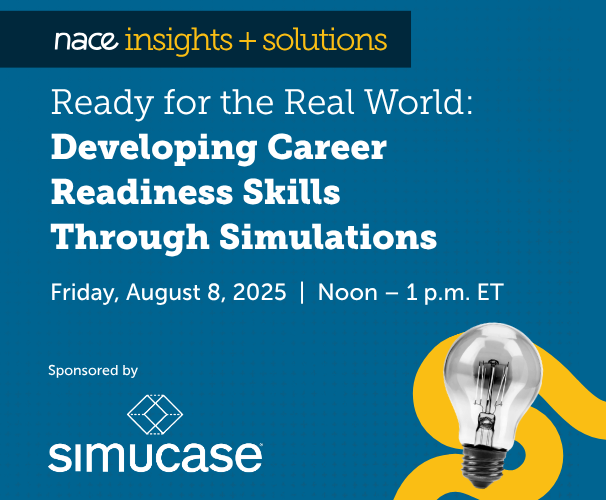Spotlight for Career Services Professionals
When Tammy Spenziero was leading career readiness in the Lally School of Management at Rensselaer Polytechnic Institute (RPI), she found tremendous benefits in holding reverse career fairs at small scale with specific program areas: business, finance, IT, arts, and more.
“It works well at small scale and provides an intimate setting where students can have an amazing conversation one on one rather than wait in a long line to give their 30-second pitch and hand over a resume,” says Spenziero, now the director of the Excelsior College Career Readiness Center.
“RPI’s main centralized career center continued to hold a larger-scale career fair.”
She says that by definition, the smaller events were reverse career fairs.
“However,” Spenziero adds, “we decided to introduce them as small-scale networking events with the same purpose. We called them ‘industry career chats,’ ‘food and folks in the field,’ ‘alumni networking,’ and more. This eliminated the stigma of ‘career fair’ to attract attention. These were small-scale casual networking events that put students in the driver’s seat.”
She worked to have an equal number of employers and students, between 20 and 50.
“We held these to bridge the gap between industry employers and our students,” Spenziero says.
“The purpose was to open the door in a comfortable setting, allowing our students to meet and connect in with those in the field. This was not only for our pipeline of employer partners, but our alumni employers as well. Employers could engage and learn about our students and their career interests.”
With the “reverse” format of the event, students do not have to wait in a line to give a 30-second sell or 60-second pitch, hand over a resume, and hope they are remembered.
“They don’t have to dress in an animal costume or hop on one leg,” Spenziero says.
“We actually did have a student who did this. I will never forget him, and neither will anyone who attended that career fair. It shouldn’t have to be that way.”
She adds that students should have learning experiences beyond the classroom and academic setting from those in the field in which they are interested.
“Their future should be full of possibilities without the waiting, the stress, and the feeling that they need to be ‘pitch perfect.’ They should have real world connections, engage early with the career center, and forge meaningful relationships with alumni and other employer partners. All of this is networking … reverse career fairs are networking.”
Reverse career fairs can create a career community and an open network to employer connections for students. Furthermore, they can yield possibilities for enhanced experiential learning and for valuable mentors in their fields of interest.
At RPI, Spenziero marketed the reverse career fairs to students as chance to learn about the industry and their fields of interest firsthand from those in it. To employers, she marketed the fairs as networking events with top talent where students set the stage.
“We guarantee that students will make at least one valuable connection as long as they put their networking skills into practice,” Spenziero notes.
“These are learning experiences and a way to start building connections and prospects in the field in a casual setting.”
On the other hand, she explains, larger-scale career fairs are overwhelming, lack personalization, and elevate anxiety and stress.
During reverse career fairs, students are behind the tables. Employers approach and introduce themselves to the students.
“We have set these up in several ways,” Spenziero says.
“We’ve had high-top tables with no chairs. There were no big displays, no resumes, no standing in a line, and no three-piece suits, but instead, professional casual dress. Name tags that indicated students’ fields of interest went a long way, as did table grouping by program majors and career interests, and their own business cards. We would specifically tell students not to bring resumes as we wanted them to focus on making real connections.”
The key, she says, was for students to get to know employer partners first, make a positive impression, provide them with contact information, and reach back out to them after the event.
“Resumes could be sent later, once the student knows more about the employer and any open opportunities,” Spenziero says.
Pre-event, she helped students create business cards that included their full name and contact info, program major/career interest, and graduation date, as well as their LinkedIn account, link to their electronic portfolio or website, and, in some cases, their photo.
Later they were given tips and best practices on how to follow up with everyone they met during the event.
“This isn’t a middle school science project looking situation,” Spenziero points out.
“It’s adults networking in the real world.”
Following the event, Spenziero surveyed all attendees to ask them what it yielded, what they liked, what could be improved, and what did not work, as well as suggestions for improvement.
“In the end, we hoped it yielded mentors; connections; and open doors for experiential learning, job opportunities, career goal direction or redirection, and more,” Spenziero says.
“We didn’t measure success of the event simply by the quantity of business cards obtained and the number of people involved. We measured it by the simple fact that those who attended got what they set out for, a new connection to open a door.”
She has several recommendations for developing and holding effective reverse career fairs, including making them small, holding several throughout the year, and keeping them laid back in an environment that is comfortable where employers and students have no requirements or checklists to follow.
“We know all too well that the big career fairs are stressful for everyone involved, are costly, involve many resources, and are time-consuming,” Spenziero says.
“While generating revenue is important, we look to other creative ways to make up for this, such as through sponsorships, tiered incentives, marketing opportunities on campus and online, virtual events, and more.”
Also, she adds, have a coordinator or volunteers—including students—help with reverse career fairs.
“Do not try to do it all on your own,” Spenziero advises.
“Engage student volunteers as part of a project and something they can add to their own experience in helping you. Those interested in higher ed, marketing, business, and event planning are ideal. Work with those program deans as well.”
She notes that the pandemic has shown the profession that most of the services, programs, and events that career services previously offered and held in person can be done virtually and efficiently at zero cost. For example, Excelsior College holds virtual career trek visits, which feature Go Pro tours of an office with a host, introductions to departments, panel chat follow-ups, and Q&A sessions.
“Reverse career fairs and networking events are just one example of how we can bridge the gap between employers and our students,” Spenziero says.
“Continue to get creative in this time. Innovation has been sparked by this pandemic and change is constant. Higher education must change and the way students learn and engage with the world of work must change. If we all advocate for our career centers and work to build employer connections, we are doing our part in helping students—our future—reach their professional goals.”







